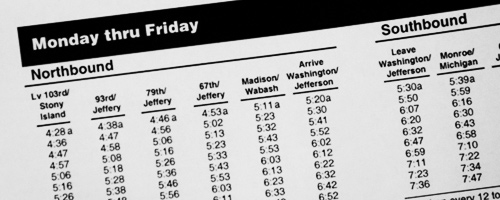Ward Score
1 5
2 5
3 9
4 5
5 9
6 7
7 2
8 4
9 3
10 1
11 3
12 6
13 3
14 4
15 3
Ward Score
16 6
17 4
18 3
19 3
20 7
21 5
22 4
23 5
24 8
25 6
26 3
27 8
28 7
29 3
30 5
Ward Score
31 2
32 7
33 8
34 2
35 7
36 2
37 2
38 2
39 3
40 4
41 4
42 10
43 10
44 10
45 7
Ward Score
46 10
47 9
48 9
49 10
50 5
Citizens Taking Action for transit dependent riders
For Information:
Charles Paidock, Secretary (312) 842-5036, (312) 714-7790 cell cpaidock@hotmail.com
Kevin Peterson (773) 896-8126 transitcatt@hotmail.com
Transit Group Study of CTA Service in Each Ward
Citizens Taking Action, a public transit advocacy organization, conducted a study of levels of service provided by CTA to passengers in each of the fifty (50) wards of Chicago. A map of all wards was overlaid with the current map issued by the transit agency. Criteria such as east and west, north and south routes, hours of bus and train operations, proximity of L stations, and if twenty-four (24) hour travel was possible, or travel restricted to only rush hours or early evenings only.
Charles Paidock, Secretary, stated that: “Our primary aim is to get elected officials to seriously take a look at the level of service in their areas, which I don’t think too many of them have taken the time to do. While doing this study, far too often it was remarked by someone that “I wouldn’t want to live there.” Although such a study admittedly does not have absolute scientific precision, I am confident in the accuracy of the results arrived at by our members, who are transit dependent riders, and use CTA everyday. There’s no one better to ask about public transit. I anticipate we’ll get plenty of defensive arguments and criticism from either the agency, or locally elected officials, if their ward got a low score.”
Kevin Peterson said: “We got tired of some of the outrageous claims being made by transit officials about service levels, and the studies done by the so-called, paid transit experts on the staff in certain organizations, or pricy consultants, whom we don’t think know what they’re talking about. When you’re either made to wait on a cold day, or have no way to get home, you begin to take the transit schedules fairly seriously. It’s sad that we couldn’t find many wards, actually only five (5), which deserved a score of ten (10) for excellent service. The average score was 5.4.”
We Ride, And We Vote

